2017 Yamaha FZ-09 Review: First Ride

Getting to know the update of the popular Triple
The fact that most of MO’s editors are quite fond of Yamaha’s FZ-09 is fairly common knowledge. Our readers liked the FZ-09 enough to vote it Reader’s Choice Best Value Bike Of 2015. So, why is it that, up until now, the primary emotion I felt after riding the FZ-09 was disappointment? Frankly, I felt it never lived up to its potential. Two of its strongest attributes – the versatile engine and the responsive chassis – were hamstrung by a slight deficiency in Yamaha’s typically good R&D finish. Well, that was then.
2017 Yamaha FZ-09
| Engine | 18.5/20 |
| Suspension/Handling | 12.75/15 |
| Transmission/Clutch | 8.25/10 |
| Brakes | 9.0/10 |
| Instruments/Controls | 4.0/5 |
| Ergonomics/Comfort | 9.25/10 |
| Appearance/Quality | 9.5/10 |
| Desirability | 9.0/10 |
| Value | 9.0/10 |
| Overall Score | 89.25/100 |
More For Less: $8K Four Vs. $8.2K Triple Vs. $8.7K Twin + Video
Today, I’m happy to report that, after a day in the saddle of the 2017 Yamaha FZ-09, I no longer need to feel conflicted about the missed opportunity of the FZ’s performance. I can embrace it wholeheartedly – and in the way that only the converted can after wandering for years in the wilderness – exclaiming that Yamaha has finally put the FZ-09 through finishing school.
Triple Play
What’s not to love about an 847cc Triple that rolls out the power via an 120° crossplane crankshaft? Well, in its first generation, it was snatchy fuel delivery, but much of that was taken away in the following iterations. Still, for a rider who values smooth throttle application, the engine wasn’t quite there – until now. For 2017, the EFI received the same settings as the FJ-09 and the XSR900, which finally tames most of the abruptness previously encountered going from off-throttle back on. While some occasional abruptness can appear – though not consistently – in the lower mid-range (think roughly between 4,000 and 5,000 rpm), this trait has been relegated to niggle status and is no longer one of the defining characteristics of the engine. This is hugely good news!
Now, the rider is rewarded with a smooth, meaty torque curve that in our previous tests twisted out 59.7 lb-ft at 8,600 rpm and a horsepower curve that stayed above 100 hp (peaking at 106 hp) from 9,000 rpm to the 11,250 rpm redline. Finally, even for a persnickety rider like myself, all three D-Modes are completely usable. While most riders will likely stay in Standard Mode, the more aggressive A-Mode is no longer an exercise in frustrating abruptness. Yes, the initial throttle response is noticeably more reactive – a trait riders who like to whack the throttle to its stops at corner exits will surely love – but this doesn’t come at the expense of the ability to precisely meter out thrust as the rider plays out the power requirements of unfamiliar corners. Now, because Standard mode is so smooth, B-Mode might best be relegated to rain-use status.
The improved EFI isn’t the only electronic upgrade to the 2017 FZ-09. The left grip features new switchgear to allow for a TC toggle. The FZ-09’s traction control has three settings: 2, high intervention geared towards everyday street riding; 1, low intervention for higher performance sport riding; and OFF, for no TC at all. My time in the FZ’s saddle was predominantly in level 1, though I did briefly sample level 2. The only times I felt TC intervene was in some of the dirtier corners where it did exactly what it was designed to do, namely keep me from landing on my head. Although I may not be of the wheelie persuasion, I noticed that several of the other moto-journos has no issues with lofting the front wheel during photo passes. A quick inquiry netted the information that, no, the TC had not been turned off. Rest assured, hooligans, you can raise hell and have your TC engaged, too, just like on the XSR900 we loved.
The final change in the engine is the only mechanical one made in the transition from 2016 to 2017. Slip-assist clutches are all the rage these days, and for good reason. Our ride started with the urban bump-and-grind and finished with 5 miles of lane splitting. Having a clutch lever with a 20% lower effort is a huge quality-of-life improvement in these situations. The clutch action was so light that it felt like that of a much smaller-displacement engine. Although I never blow a downshift and, thus, would never benefit from the slipper action (yeah, riiiiight), I did test its function for you, gentle reader, and the times that I downshifted and dumped the clutch – again, strictly for slipper-testing purposes – had the back end remaining stable with none of the histrionics of a traditional clutch pack.
Finally, Suspenders
My biggest beef about the FZ-09 of old was the suspension. When the pace got too hot or the road got too bumpy, they turned mushy and allowed the chassis to get out of shape. Thankfully, Yamaha decided to address the issue in the front end by adding an adjustable compression circuit to the inverted 41mm fork. Previously, the fork had only preload and rebound damping, which was located in the right leg, leaving the left leg with available real estate for this year’s upgrade. According to Yamaha, the fork has 83% more compression damping, and just like that, the FZ-09 is transformed when the road gets bumpy or the aggro-meter gets turned up.
From the moment we pulled out onto the street, the FZ’s additional firmness was readily apparent. This is not to say the suspension is harsh at more sedate speeds, rather I always felt like I knew what the front end was up to. So, when the pace heated up and the road was less than putting-green smooth, I was quite aware of the contact patch’s condition. This is so much better than wondering WTF the chassis was doing as it danced around underneath me as with previous FZ-09s.
Reader’s Choice Best Value Bike Of 2015: Yamaha FZ–09
With the increased confidence from the suspension, I was able to use the lightweight, Controlled Fill aluminum chassis for what it was designed for. Side-to-side transitions are quite literally a snap. Diving into a downhill, decreasing-radius corner is more fun with significantly less pucker than before. While the fork’s standard settings worked well for my 190 lbs of motorcyclist and gear, I’d probably add a couple clicks of rebound damping to the rear (if I still had the FZ-09 in my possession) to control the occasional sproing on G-out compression bumps. Alas, that’s the limitation of a one-day ride.
But Wait, There’s More!
Yamaha didn’t just sit back and say the job was done after addressing the FZ-09’s biggest issues. Instead, ABS was brought into the spec sheet. This is a good safety feature for a streetbike because you never know when someone will do something boneheaded in front of you. And when they do, you might not have the best traction available. The FZ’s brakes have always been good. The Brembo master cylinder combines with the Yamaha 4-piston, radial-mount calipers to deliver great braking performance with good feel in a wide range of conditions. ABS takes none of that away, and in a few full-boogie braking maneuvers that would have had previous generations of ABS intervening a bit early, the FZ remained unfazed. Still, when I mashed on the rear brake to see what it took to get it to save me from myself, the pedal gently pulsed, letting me know it had my back.
2017 Yamaha FZ-09
+ Highs
- Fully-adjustable fork!
- Smooth throttle response (finally)
- TC and ABS
– Sighs
- Shock not as capable as fork
- Price increase
- Weight gain
Braking is the perfect context to point out a small-but-significant change to the FZ-09’s seat. With a flatter profile and a 5mm increase in height at the front of the saddle, the rider is less likely to slide forward into the tank on bumpy roads or during braking. The seat’s narrowness still allows an easy reach to the ground with plenty of room for the rider to move around during different riding situations. Passengers will appreciate the 13mm longer pillion. This was accomplished while still allowing for a 29mm shorter subframe, though much of the credit for this goes to the Euro-style relocation of the license plate to a single-sided aluminum stay that has it hovering over the rear tire.
New Clothes
At last we arrive at the FZ-09’s styling makeover. While not exactly earth-shattering, the 09 has clearly been going to the same gym as its big brother, the FZ-10. The FZ-09 gets an angry, four-beamed battle-mask mounted to the fork. The bodywork below the tank is also more in line with that of its sibling, while the Matte Silver with Neon Yellow color scheme is more than a passing nod to the FZ-10.
Usually, we get to this point in a first-ride review and tell you how long you’ll have to wait to get yer mitts on one of these exciting new bikes. This time, however, you have the chance to do some long-term testing before the Mighty MO Editors have a chance to log a few thousand miles. The FZ-09 is arriving in dealerships now.
One could be yours in Matte Silver with Neon Yellow, Intensity White, or Candy Red for just $8,999. While that is $809 more than last year, you do get improved EFI mapping, TC, a fully adjustable fork, and ABS for those extra dollars. Sample the 2017 Yamaha FZ-09, and you’ll probably think that it was money well spent.
2017 Yamaha FZ-09Specifications | |
|---|---|
| MSRP | $8,999 |
| Engine Type | 847cc liquid-cooled DOHC inline 3-cylinder 4- stroke; 12 valves |
| Bore and Stroke | 78.0mm x 59.1mm |
| Compression Ratio | 11.5:1 |
| Rear Wheel Horsepower | N/A |
| Torque | 64.5 lb-ft @8,500 rpm (claimed) |
| Transmission | 6-speed |
| Final Drive | Chain |
| Front Suspension | 41mm inverted fork; adjustable preload, compression, and rebound damping; 5.4-in travel |
| Rear Suspension | Single shock, adjustable preload and rebound damping; 5.1-in travel |
| Front Brake | Dual 298mm discs, 4-piston calipers, ABS |
| Rear Brake | Single 245mm disc, one-piston caliper, ABS |
| Front Tire | 120/70ZR17 |
| Rear Tire | 180/55ZR17 |
| Rake/Trail | 25.0° / 4.1 in. |
| Wheelbase | 56.7 in. |
| Seat Height | 32.1 in. |
| Curb Weight (Claimed) | 425 lb. (wet) |
| Fuel Capacity | 3.7 gal. |
| Colors | Candy Red, Matte Silver and Intensity White |
| Warranty | 1 Year (Limited Factory Warranty) |

Like most of the best happenings in his life, Evans stumbled into his motojournalism career. While on his way to a planned life in academia, he applied for a job at a motorcycle magazine, thinking he’d get the opportunity to write some freelance articles. Instead, he was offered a full-time job in which he discovered he could actually get paid to ride other people’s motorcycles – and he’s never looked back. Over the 25 years he’s been in the motorcycle industry, Evans has written two books, 101 Sportbike Performance Projects and How to Modify Your Metric Cruiser, and has ridden just about every production motorcycle manufactured. Evans has a deep love of motorcycles and believes they are a force for good in the world.
More by Evans Brasfield




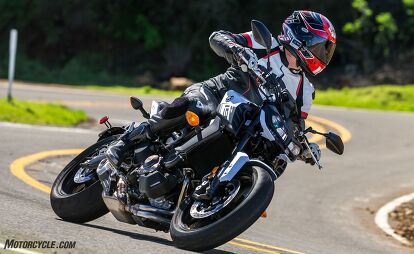








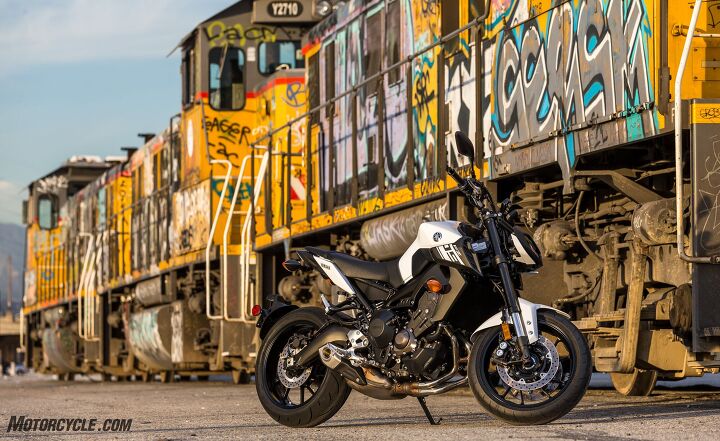















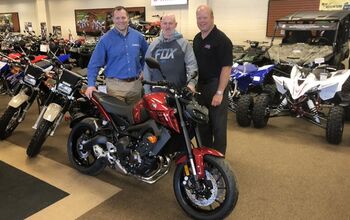
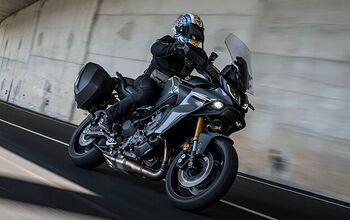
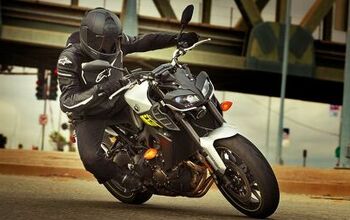
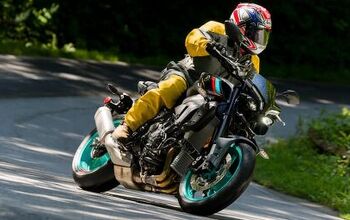
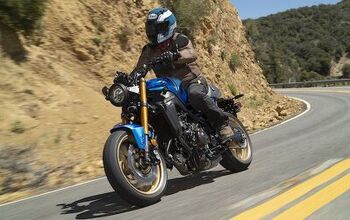










Comments
Join the conversation
When you go from a 689cc twin to a 847cc triple, you increase the fuel capacity, Yamaha. Just do it already. Other bikes have been using a 17L (4.5gal) capacity for ages. Give it some range. The FJ has a bigger tank but that's a whole nother bike.
Throttle response: Doesn't totally suck. Suspension: Doesn't totally suck. Great motor. Still butt ugly though.